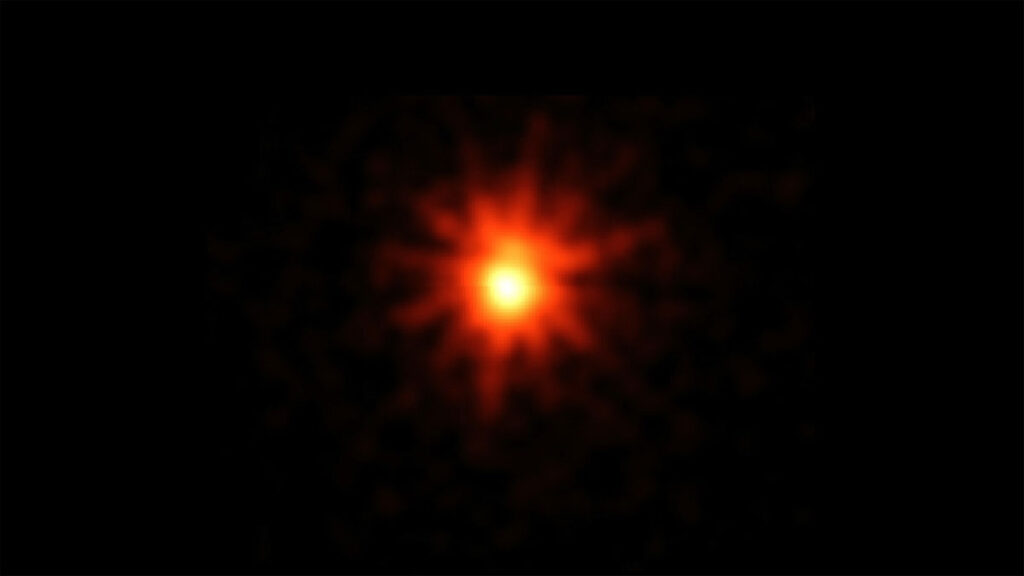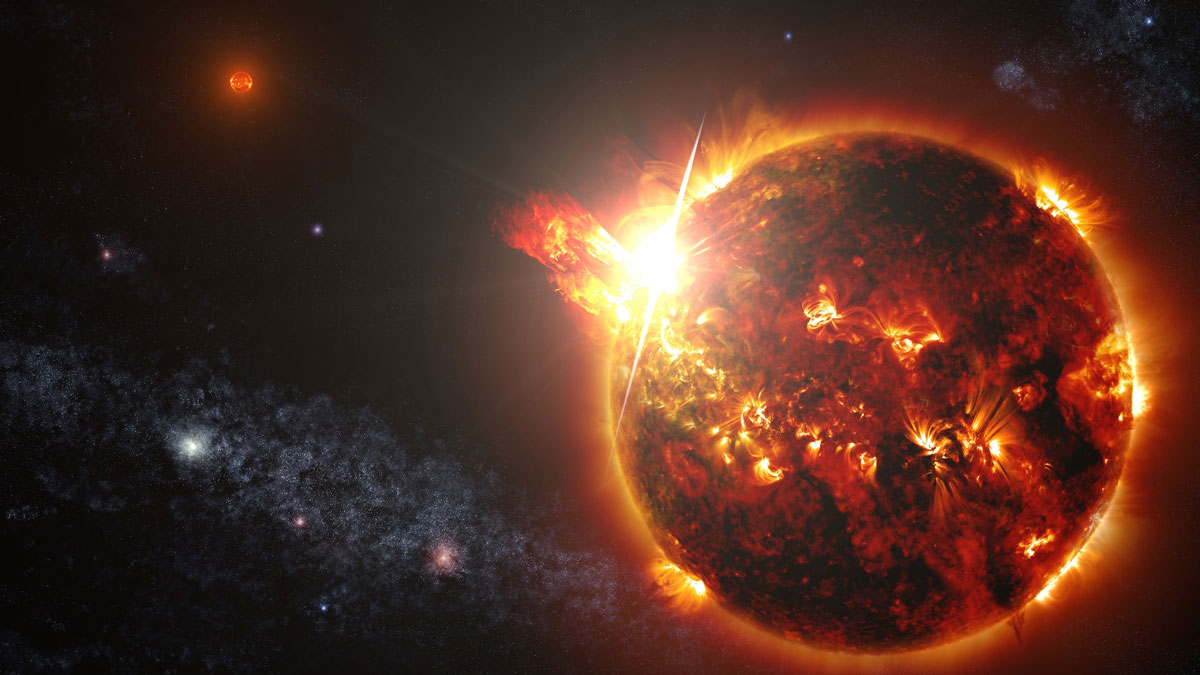When stars flare, they release bursts of electromagnetic energy into the space around them. For decades, astronomers have debated the impact of that energy on the habitability of exoplanets, especially those around small, cold, red stars called M dwarfs. The habitable zone around such stars is much closer to the star than Earth is to the Sun, so the flares are thought to have a big effect on the potential for life.
But what that effect is, exactly, depends greatly on the strength and type of ultraviolet (UV) radiation a flare produces, explained Vera Berger, a physics doctoral student at the Massachusetts Institute of Technology in Cambridge. UV radiation from flares can power chemical reactions that can support life but can also strip away a planet’s ozone or atmosphere, which is detrimental for survival.
Now, new research from Berger and her colleagues has analyzed more than 180 M dwarf flares to better understand the UV radiation they produce. The researchers found that M dwarf flares contain an average of 3 times more high-energy UV radiation than expected, suggesting that those flares could have a larger-than-anticipated impact, whether good or bad, on habitable zone planets.
Far More Flux in the Far UV
M dwarf stars, small but still powered by hydrogen fusion, are the most common stars in the galaxy. Many of the possible rocky planets so far detected around these stars orbit in the habitable zone, the ideal distance from a star for a planet to sustain liquid surface water.
But with those exoplanet detections came a quandary: Could life on those planets survive the powerful flares M dwarfs regularly produce?
“These M dwarf stars are super quiet in the UV, except when they’re flaring,” Berger said. “There’s just so many orders of magnitude more far-UV emission” during a flare.
Until recently, there had not been a large-scale, time-sensitive survey of flaring stars, so astronomers estimated the energy distribution of M dwarf flares on the basis of the “Great Flare” of the star AD Leo in 1985. That estimate suggests that M dwarf flares have 6 times less high-energy (far) UV radiation than low-energy (near) UV radiation.
Under the assumption that other M dwarf flares share this same energy distribution, astronomers have made contradictory predictions about the impact of M dwarf flares on potentially habitable exoplanets: Flares might help create life, or they might be its death knell.

Berger and her colleagues set out to test this assumption. Using data from the European Space Agency’s Gaia satellite, they put together a catalog of M dwarf stars within 100 parsecs (326 light-years) of the Sun. They then combed through archival data from the now decommissioned NASA Galaxy Evolution Explorer (GALEX) ultraviolet space telescope and discovered 182 flares on 158 of those stars. The GALEX data provided near- and far-UV flux measurements for each flare.
“Here, we’re seeing really high levels of far-UV emission.”
The team found that for the flares measured, the far-UV flux was roughly 3–12 times higher than expected from the AD Leo model. That extra flux might have come from a broad range of far-UV wavelengths, which would suggest that the flares are hotter than expected, or it might have been emitted at a few particular UV wavelengths.
“Here, we’re seeing really high levels of far-UV emission,” said Berger, who conducted this research while studying at the University of Hawaiʻi at Mānoa and the University of Cambridge in the United Kingdom. “That might mean that there’s a ton of far-UV radiation through emission lines, and that would have implications for the photochemistry of [an] exoplanet that’s receiving all of this radiation.”
The researchers published this discovery in the Monthly Notices of the Royal Astronomical Society.
Habitable or Not?
This research could help astronomers better understand the evolution of and environment around flaring M dwarf stars. But whether or not the additional far-UV flux is ultimately harmful or helpful to a habitable planet would depend on how often strong flares occur, said Sukrit Ranjan, a planetary photochemist at the University of Arizona in Tucson who was not involved with the research.
“Flare events could be helpful for getting life started,” he explained. “UV light has been shown in laboratory experiments to be helpful for the abiotic synthesis of biomolecules from planetary precursors, for example, ribonucleotides which are required for the RNA world theory for the origin of life.” If the extra far-UV flux comes from only a few wavelengths, it might be broadly helpful for starting life.
However, too many strong UV flares are likely to chip away at an exoplanet’s protective ozone layer or evaporate the atmosphere completely. If the extra far-UV flux is from a wide range of wavelengths, it might break atmospheric gases down into lighter components that can more easily escape a planet’s gravity.
“If there is no atmosphere, then surface liquid water is not stable, so the planet is not ‘conventionally’ habitable in an Earth-like sense,” Ranjan said. “It might still maintain subsurface oceans if it’s Europa-like.” However, such a biosphere isn’t detectable by current methods, he added.
“Flaring is having a greater impact on planets than people typically assume.”
Determining which is the case for any particular M dwarf will require measuring the UV spectrum of several of the star’s flares, Berger said. Future observatories, such as satellites from NASA and the Israel Space Agency, will have that capability.
Either way, “flaring is having a greater impact on planets than people typically assume,” Berger said. “And I think a good number of people think that M dwarfs are just not a good target for habitable planets anymore.”
—Kimberly M. S. Cartier (@AstroKimCartier), Staff Writer

